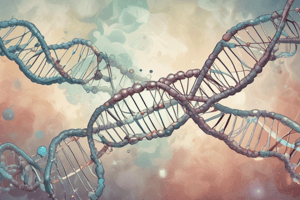Podcast
Questions and Answers
Describe the structure of enzymes and their properties.
Describe the structure of enzymes and their properties.
Enzymes are typically globular proteins with specific three-dimensional structures. They have an active site where the substrate binds, and their properties include specificity for substrates and sensitivity to environmental factors such as pH and temperature.
Explain the role of enzymes in biochemical reactions and how they affect the reaction rate.
Explain the role of enzymes in biochemical reactions and how they affect the reaction rate.
Enzymes act as biological catalysts that lower the activation energy required for a biochemical reaction to occur, thereby increasing the reaction rate.
What are the different factors that can affect the rate of enzyme activity?
What are the different factors that can affect the rate of enzyme activity?
Factors affecting enzyme activity include temperature, pH, substrate concentration, enzyme concentration, and the presence of inhibitors or activators.
Classify enzymes based on their mode of action and provide examples for each class.
Classify enzymes based on their mode of action and provide examples for each class.
Signup and view all the answers
Explain the various mechanisms of enzyme regulation and give an example of each mechanism.
Explain the various mechanisms of enzyme regulation and give an example of each mechanism.
Signup and view all the answers
Explain the concept of energy of activation and its significance in biochemical reactions involving enzymes. How do enzymes lower the energy of activation?
Explain the concept of energy of activation and its significance in biochemical reactions involving enzymes. How do enzymes lower the energy of activation?
Signup and view all the answers
Define enzyme inhibitors and provide examples of different types of enzyme inhibitors. How do enzyme inhibitors affect enzyme activity?
Define enzyme inhibitors and provide examples of different types of enzyme inhibitors. How do enzyme inhibitors affect enzyme activity?
Signup and view all the answers
Discuss the use of plasma enzymes as laboratory tools to diagnose clinical diseases. Provide examples of specific enzymes used in clinical diagnosis and the diseases they are associated with.
Discuss the use of plasma enzymes as laboratory tools to diagnose clinical diseases. Provide examples of specific enzymes used in clinical diagnosis and the diseases they are associated with.
Signup and view all the answers
Explain the different mechanisms of enzyme regulation and provide examples of each mechanism. How do these mechanisms control enzyme activity?
Explain the different mechanisms of enzyme regulation and provide examples of each mechanism. How do these mechanisms control enzyme activity?
Signup and view all the answers
Describe the structure of enzymes and their properties. How do these structural features contribute to enzyme function and specificity?
Describe the structure of enzymes and their properties. How do these structural features contribute to enzyme function and specificity?
Signup and view all the answers



